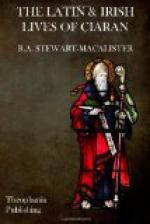29. The gospel-book of Saint Kieranus fell into the lake from the hand of one of the brethren, who held it carelessly when voyaging. For a long time it was therein, under the water, and was not found. But on a certain day, in summer, the kine entered the lake to refresh themselves in the waters, for the greatness of the heat; and when the kine had returned from the lake, the binding of the leather satchel containing the gospel-book caught about the hoof of a cow, and so the cow dragged the book-satchel on her hoof as she came to land. And the gospel-book was found in the rotten leather satchel, perfectly dry and clean, without any moisture, as though it had been preserved in a book-case. Saint Kiaranus with his followers were rejoiced thereat.
XLI. HOW CIARAN WENT FROM INIS AINGIN TO CLONMACNOIS
30. After this a certain man of Mumonia, to wit of the people of Corco Baiscind, by name Donnanus, came to Saint Ciaran as he sojourned in Inis Angin. To him one day Saint Kiaranus said, “What seekest thou, father, in these coasts?” Saint Donnanus answered, “Lord, I seek a place wherein to sojourn, where I may serve Christ in pilgrimage.” Saint Kiaranus said to him, “Sojourn, father, in this place; for I shall go to some other place, for I know that here is not my resurrection.”
Then Saint Kyaranus granted Inis Angin with its furniture to Saint Donnanus, and came to a place which is called Ard Mantain, near the river Sinna; but being unwilling to remain in that place, he said: “I will not live in this place: for here shall be great abundance of the things of this life, and earthly joy; and hardly could the souls of my disciples attain to heaven, were I to have dwelt here, for this place belongs to the men of this world.”
Thereafter Saint Kiaranus left that place, and came to a place which once was called Typrait, but now is called Cluain meic Nois. And coming to this place he said: “Here will I live: for many souls shall go forth in this place to the kingdom of God, and in this place shall be my resurrection.”
Then most blessed Kiaranus with his followers dwelt, and began to found a great monastery there. And many from all sides used to come to him, and his parish was extended over a great circuit; and the name of Saint Kiaranus was much renowned over all Ireland. And a shining and holy settlement, the name of which is Cluain meic Nois, grew up in that place in honour of Saint Kiaranus; it is in the western border of the land of Ui Neill, on the eastern bank of the river Synna, over against the province of the Connachta. Therein are the kings or the lords of Ui Neill and of the Connachta buried, along with Saint Kiaranus. For the river Synna, which is very rich in various fish, divides the regions of Niall, that is, of Midhe, and the province of the Connachta.




